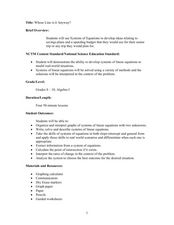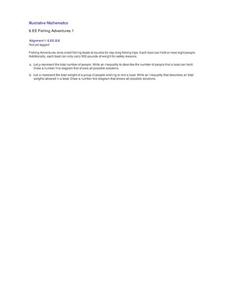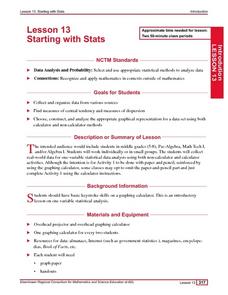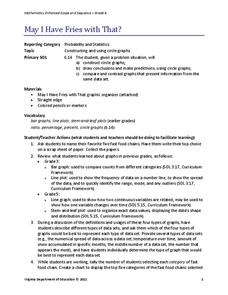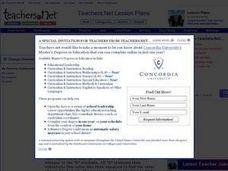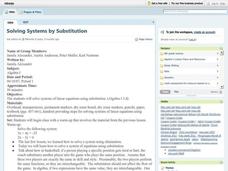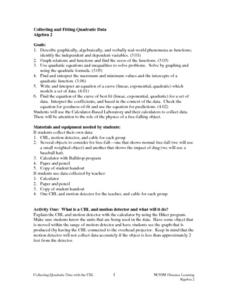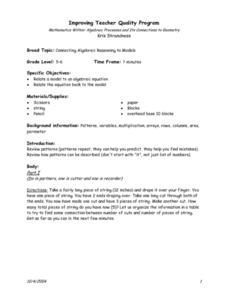Curated OER
Whose Line is it Anyway?
Learners solve systems of equations. In this algebra lesson, students identify the domain and range of each function. They use the slope and y-intercept to graph each line.
Curated OER
Inequalities and The Order of Operations
Middle and high schoolers investigate how to solve inequalities. The lesson has a good guide for taking pupils through a direct instruction of the concept. You can use counting tiles in order to help kinesthetic learners.
Illustrative Mathematics
Fishing Adventures 1
Often inequalities exist in many real-world contexts but young math learners struggle with understanding how to represent that relationship in a simple equation using an inequality. This activity focuses on the basic concepts by using...
Curated OER
College Prep Algebra, Order of Operations
In this algebra worksheet, learners evaluate 9 exponential terms. They use order of operations to solve 18 rational number problems. Students use substitution to evaluate 4 problems involving variables.
Curated OER
Worksheet 16-Fall 1995
In this math worksheet, students compute the quotient of two differential amounts. They compute the trigonometric functions of a given variable. Students compute the derivatives of three functions.
Curated OER
Starting With Stats
Statisticians analyze a data set of student IQs by finding measures of central tendency and dispersion such as mean, median, mode, and quartiles. They practice using a graphing calculator to find the values and analyze box plots and...
Virginia Department of Education
May I Have Fries with That?
Not all pie graphs are about pies. The class conducts a survey on favorite fast food categories in a lesson on data representation. Pupils use the results to create a circle graph.
Project Maths
Inequalities
Which number is bigger? Using a variety of activity sheets, this unit starts with the basics of inequalities and progresses through solving compound linear inequalities. Problems cover the range of inequalities including inequality word...
Curated OER
Pass the Pencil
Students work as a team to complete a variety of algebraic equations. Variables are assigned to students who are to substitute values to help their team solve the equation.
Curated OER
Balance or Tilt?
Sixth graders investigate the concepts of a variable, constant, expressions, and equations. They solve problems which require the interpretation of expressions in and out of equations looking for solutions. Students also use a balance...
Curated OER
Solving Systems by Substitution
Students solve systems of linear equations using substitution. They investigate the steps to solving linear equations by substitution and practice problems in small groups.
Curated OER
Algebra Match
Twelfth graders identify the parts of an algebraic equation. They consider the many uses of algebra in daily life. They play a game, Algebra Match, where student pairs work to solve equations listed on index cards.
Curated OER
What's My Function?
Fifth graders utilize input/output tables to help them solve algebraic equations. They incorporate patterns, number sequences and relations to represent and analyze mathematical problems and number relationships using algebraic symbols.
Curated OER
Algebra 2 - Linear Programming
Students read real world problems, determine the variables, and set up the function using algebraic statements. After entering data into the graphing calculator, they display information in the form of graphs and scatter plots. ...
Curated OER
Algebra Wizards
Second graders are exposed to algebraic thinking by exploring the concept of a variable. They tell how many years have passed since they've seen a favorite teacher and then examine how they arrived at this number. They write equations.
Curated OER
Words to Numbers
Seventh graders translate word problems into numerical expressions. Through guided practice, 7th graders discover how to take the information contained in a word problem and create a numerical expression using variables. They...
Curated OER
Collecting And Fitting Quadratic Data
Students investigate the concept of using quadratic data to plot coordinates on a plane. They also apply the quadratic formula for a variety of problems with the help of a graphing calculator to draw the parabola for given coordinates.
Curated OER
Linear Patterns in Data
Eighth graders extend their learning of graphing linear equations and are introduced to connecting patterns in tables and graphs to represent algebraic representations. They then determine patterns and extrapolate information from these...
Curated OER
Population: Logistically Speaking
For this population worksheet, students read word problems relating to population growth. They write the problem as a differential equation, create models and graphs of the solution. This three-page worksheet contains 10 multi-step...
Curated OER
Sloping and Intersecting a Linear Function
Students examine and discuss typical linear equations, and the difference between a linear and nonlinear equation. They observe examples of linear equations and complete a worksheet.
Curated OER
Earthquakes
Eighth graders demonstrate the mathematical components of a scientific problem as well as illustrate how real world problems can be solved using math. They demonstrate math skills such as rate calculation, graphing, and linear equations.
Curated OER
How Old Did You Say?
Second graders explore and develop algebraic formulas based on their own ages as the known variable. This is a clever, and simple, way to introduce the concept of algebra to young students.
Curated OER
Double This
Learners change verbal expressions to algebraic equations. They practice the vocabulary of algebraic equations.
Curated OER
Connecting Algebraic Reasoning to Models
Students analyze relating a model to an algebraic equation and visa versa. Patterns are reviewed in detail and then in pairs new models are created and then translated into a word problem or equation. They illustrate their models on...
